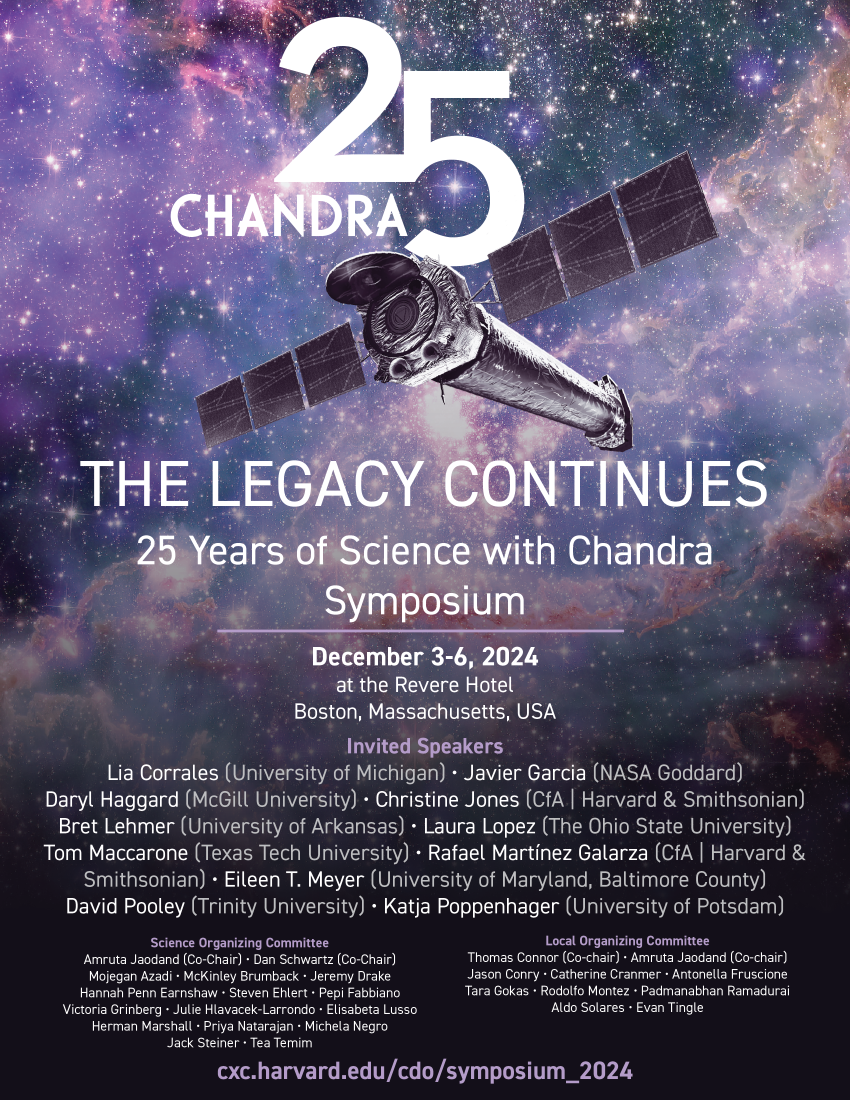Celebrating 25 Years of Science with Chandra
Amruta Jaodand and Dan Schwartz for the Organizing Committees
Conference Rationale
Launched on July 23, 1999, the Chandra X-ray Observatory remains at the forefront of astronomy, mapping the high energy sky at unprecedented angular and spectral resolution. In many ways, the launch of Chandra captures the arc of X-ray astronomy—starting with the original 1976 proposal by Riccardo Giacconi and Harvey Tananbaum. It took another 23 years of persistent efforts from astronomers, a leap of technology maturation, and a rescoping of the mission for that vision to be realized as one of NASA’s four Great Observatories. Of those four, Hubble and Chandra remain operational today, with Chandra still single fault tolerant and performing observations at near-launch efficiency.
Twenty-five years on, Chandra is still a powerful mission, with its sub-arcsecond resolution enabling orders of magnitude improvement in X-ray imaging capability. The combination of high spatial, spectral, and timing resolution, along with deployment in a highly elliptical orbit, allows Chandra to conduct deep exposures unencumbered by the charged particle environments that surround Earth. The request for Chandra time therefore remains strong, with an oversubscription rate exceeding 4.5 times the available time in recent years.
Chandra has continued to revolutionize our understanding of various domains of astronomy, such as stellar science, accretion and jets, time-varying transients, galaxy formation and AGN feedback, and cluster physics and cosmology. Very recent Chandra discoveries include new constraints on the neutron star equation of state through investigations of cold neutron stars in supernova remnants, identification of nearby stars that could host habitable planetary systems, discovery of the exhaust vent in the Galactic Center, and the detection of the most distant supermassive black holes. Many of these science ideas were not even thought of at the time of the launch of Chandra.
In fact, the continued impact of Chandra discoveries can be witnessed through the more than ten thousand refereed publications based on Chandra data, which have been cited almost half a million times. With a continuing publication rate of around 400 publications per year, Chandra is one of the most prolific scientific observatories in the world. Impressively, Chandra datasets have also contributed to 729 PhDs, which directly reflects the mission’s impact in training young astronomers. And, as the mission continues, it leaves a growing legacy: twenty-five years of archival observations and a robust and well-documented source catalog.
Chandra's sharp X-ray vision combined with high resolution spectroscopy have produced some of the most detailed images, spectra, and light curves of variable and energetic X-ray sources in the universe. These unique capabilities are critical as we step into new eras of time domain astronomy, gravitational wave astronomy, and deep infrared astronomy. From JWST and Euclid to the Roman Space Telescope and the Rubin Observatory, and in conjunction with LIGO-VIRGO-KAGRA, the next ten years are poised to be full of new sources and new discoveries; Chandra is crucial to gain a comprehensive understanding of celestial objects in this panchromatic and multi-messenger future of astronomy! While JWST, Roman, and Rubin will continue the scientific legacy of some of the great observatories, there is no replacement on the horizon for Chandra yet.
This year, with Chandra having completed twenty-five years in operation, we celebrate its rich scientific legacy and the discoveries that await us!
A Celebratory Symposium
The Chandra X-ray Center is pleased to announce the “25 Years of Science with Chandra Symposium,” to be held December 3–6, 2024, in Boston, Massachusetts, highlighting and celebrating the rich scientific legacy of Chandra.
The symposium will cover various areas in X-ray astrophysics where the spatial, temporal, and spectral resolution of Chandra have played a key role, as well as the landscape of Chandra discoveries that lie ahead. Eleven invited speakers, covering diverse demographics and career stages, have committed to review and forecast those topics. We anticipate scheduling about 50 contributed talks of 15 minutes each (including questions) and over 100 posters, with extended breaks with refreshments for poster viewing and discussion. The long-time NASA Project Scientist, Martin Weisskopf, and the founding CXC Director, Harvey Tananbaum, will share their experiences with the development of the mission and its scientific impact, and the STS-93 astronauts will share some of their memories on the opening afternoon.
Full details can be found on the Symposium website: cxc.harvard.edu/cdo/symposium_2024/.
The science achieved by the Chandra X-ray observatory is made possible by the tireless efforts of many partners working together as a single Chandra team, by strong community interest, and by the participation of thousands of astrophysicists worldwide. We hope the symposium will bring together everyone who has been a part of this wonderful journey to celebrate the twenty-five years of Chandra.
Abstract submission is currently open (at this link), with a deadline of August 11; we are accepting abstracts for both talks and poster presentations. Speakers should expect to be notified by September 13.
Registration is currently open (on Eventbrite) to everyone, with a regular registration deadline of October 25. Regular registration is $600, or $300 for students. The deadline for both late registration and poster submission is November 8.
The meeting will take place at the Revere Hotel in downtown Boston. The Revere is a block away from Boston Common and easily accessible by public transit. We have reserved a block of rooms, which are available from Monday, December 2, to Saturday, December 7, at only $169/night. Room reservation information can be found on the conference website.
Important dates for the meeting include:
Abstract Submission Deadline: August 11, 2024
Speakers Notified: September 13, 2024
Program Release: September 20, 2024
Regular Registration Deadline: October 25, 2024
Late Registration and Poster Submission Deadline: November 8, 2024
Start of Symposium: December 3, 2024
Don’t forget to submit your abstract by August 11! We look forward to seeing you this December.
 The Conference poster
The Conference poster